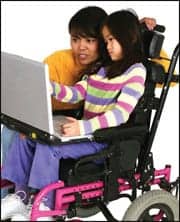 |
Today’s breed of power wheelchairs offers pediatric clients many advantages—particularly for the very youngest of clients, those with a need to independently explore the environments in which they live and to have better interaction with other kids.
“Power wheelchairs can be a good choice now for children as young as 12 to 15 months,” says pediatric and standing specialist Amy Meyer, PT, ATP, of Lebanon, Tenn, who works for wheelchair manufacturer Permobil.
Meyer notes that there is significant interest in getting kids into power wheelchairs at earlier and earlier ages, and that this interest is being bolstered by a growing body of research. “Among the more important studies currently under way is one from the University of Delaware, Newark, where they’re attempting to determine if some form of power mobility, such as robotics, can and should be used by kids as young as 6 months,” she reports. “What we know already from earlier research is that power mobility in the right situations is beneficial for social development, development of confidence and self-help skills, and development of visual perceptual skills.”
POINT, COUNTERPOINT
 |
Even so, among very young children, the most common mobility solution remains a manual wheelchair.
“Kids in their early years can relatively quickly outgrow a wheelchair, long before the wheelchair mechanically wears out and needs to be replaced—which is a big reason why insurance companies and other funding organizations traditionally have been hesitant to purchase power wheelchairs for them,” says Maria Jones, PT, PhD, ATP, clinical assistant professor, Department of Rehabilitation Sciences, College of Allied Health, University of Oklahoma Health Sciences Center, Oklahoma City.
There also is the issue of safety. “Many clinicians and families don’t believe a very young child can successfully operate a power wheelchair without colliding into people and objects,” says Jones, “so a manual wheelchair is thought to be a safer choice.”
Also of concern is exercise: how much of it will a wee one receive by manipulating electronic interfaces to go forward or backward? “Some parents and therapists worry that power mobility will cause children to become lazy and not get enough exercise, so they keep children in manual wheelchairs and encourage propulsion with the upper body,” says Jones.
Good counterarguments can be raised for each objection to power mobility, Meyer assures. On funding, the developmental gains possible through use of a motorized wheelchair can be substantial enough to outweigh the cost savings of a manual rig. On safety, “you can configure a power wheelchair with emergency stop buttons, switches, and remote controllers so that a parent or even a responsible older sibling could, for instance, prevent the user from crossing the street until the traffic light turns green or from performing some other maneuver that the parent didn’t want the user doing,” she says. On exercise, even the lightest of manual wheelchairs often prove too heavy for a very young child to propel and maneuver: “If the child somehow manages to work a manual chair, it’s an achievement likely to come at a price—namely, unacceptable amounts of strain placed on those tiny shoulders, strain sufficient to cause problems in later life when the user needs a good set of shoulders for smooth, easy transfers in and out of the chair.”
INNOVATION ROLLS ON
Increasingly, clinicians—and families—are coming to accept the idea that power may be right for tots, toddlers, and all the way down the line to infants.
“I think this may be because we’re growing more and more comfortable considering the possibilities of what technology can do,” says Jones.
And, indeed, the march—or roll, as the case may be—of pediatric mobility technology continues apace in both the power and manual wheelchair categories.
Among the most important advances has been the ability to lower the wheelchair seat to the floor to allow kids to more directly interact with their peers and also to facilitate independent transfers, Jones reports. Additionally, “existing products are constantly being redesigned for more adjustability to better meet the needs of users with rapidly changing needs owing to growth and development,” she says.
Easier and safer transportation of wheelchairs has been another focus of manufacturer and family attention. “There is great interest in better ensuring the safety of kids who will be seated in a chair during the time that the chair is in a car, van or bus,” says Jones, indicating that the interest extends to the creation of systems to keep both child and chair more secure during transport.
Jones also finds that products are reaching the market to allow more options for the maneuvering of power wheelchairs. “Joysticks remain the standard option, but now head arrays, sip-‘n’-puff systems, and microswitch controls—devices formerly available primarily to adults—are readily available in the pediatric market,” she says.
Currently in development are so-called smart power wheelchairs. “These are equipped with sensors to stop the wheelchair in its tracks if a collision with a person or object is imminent or is in the process of occurring,” says Jones. Not yet widely available beyond the arena of research, such a feature might well allow power wheelchairs to be used by even younger children—those under the age of 12 months—or older ones with cognitive deficits that impair their ability to react to hazards ahead.
QUESTING FOR IDEAL WHEELS
Despite the strides in technologic advancement, it still distresses Jones when therapists complain that wheelchairs lack one or another ideal capability.
“My response is to ask the therapist whether they have communicated this to the manufacturer, and usually the answer is no,” says Jones. “Many therapists accept what’s out there. They’ll just try to make the best use of what exists.
“As therapists, I believe we have a responsibility to play an advocacy role in the process of product development. As such, I work closely with manufacturers to help them understand what users need. But manufacturers need to hear from more than just a few clinicians. They need to hear from many therapists, from many children and their families, from many different sources.”
Clearly, the perfect pediatric wheelchair doesn’t exist. But if vendors receive enough help in the way of outside input, perhaps some day it will.
Rich Smith is a contributing writer for Rehab Management. For more information, call .
Cool Mobility
As cool as some power wheelchairs are, a mobility device that might for older kids turn out to be cooler by far is the Segway PT, a two-wheeled, self-balancing scooter.
The Segway is not an FDA-approved mobility device, but that has not stopped one Delaware teenager with cerebral palsy from using it in place of a wheelchair to get around.
A client of DuPont Hospital for Children in Wilmington, Del, the teen started driving a Segway earlier this year. “It’s made a hugely positive impact on her life,” says the hospital’s Denise Peischl, BSE, rehabilitation engineer. “I’ve watched her using this device, and you should see the smile on her face when she does. It’s allowing her to have eye-to-eye interaction with her peers. Also, the Segway’s smaller footprint and turning radius allow her access to more places than would be possible with a power wheelchair.”
Peischl explains that the teen client is able to ambulate, but only for short distances. That posed no problem during the years she attended elementary school and had the luxury of spending each entire day in a single classroom. Now, however, she is enrolled at a large high school where she must change classrooms multiple times daily. Getting around unaided is now too difficult as a result.
“A question facing many of our older kids is how do they handle the mobility issues associated with campus life?” asks Peischl. “This child answered that question in what I think is a very interesting way.”
SEGUEING TO THE SEGWAY
The Segway PT is manufactured by Segway Inc of Bedford, NH. Although it is not a medical device, this fun-oriented scooter is based in part on technology used in the Johnson & Johnson iBOT—a powered wheelchair capable of going up and down stairs while keeping the user level.
There are a few drawbacks to using the Segway PT, Peischl contends.
For one, typical operation of the device is in the standing position. Users with spasticity, poor balance, or impaired motor coordination may not have enough control for operating the device safely. “Gyroscopes control the Segway’s direction—forward, reverse, right, left,” she explains. “And the gyroscopes, in turn, are controlled by the user shifting their weight while standing.”
Another downside is the Segway’s speed. It tops out at close to 13 mph. Depending on the cognitive and motor impairments of the user, that might be fast enough to pose grave danger, Peischl suggests.
Then there is the not-inconsequential matter of insurance reimbursement, In a word, there is none. “At this point, it’s entirely the responsibility of the user or the family to fund this device,” says Peischl, who believes that, even if the Segway catches on as a pediatric mobility alternative, the number of prospective appropriate users will likely be a tiny percentage of the ambulation-impaired child population.
“Interest in using something like the Segway, no matter how big it becomes, won’t in my opinion signify that there is dissatisfaction among clinicians with regard to the existing power mobility choices they have for their clients. There are plenty of choices. The problem is obtaining funding for them.”
Peischl discloses that ever-greater slices of her time are spent battling insurance companies to approve wheelchairs. “I’m probably writing appeal letters at a rate 60% greater than a year ago,” she says. “Most often, the appeal is in regard to higher-end power mobility systems that provide unique options such as power standing or seat elevators. Payors have decided that these features fall outside medical necessity guidelines. They justify that by claiming such options are unsupported by any scientific evidence, which is not true.”
Segway PT use by the disabled has scant research in support of it. However, the satisfying and rewarding anecdotal experiences of the Delaware teen, replicated enough times across the country, could go a long way toward nudging funding sources to at least give alternatives like the Segway PT a closer look.
—RS




